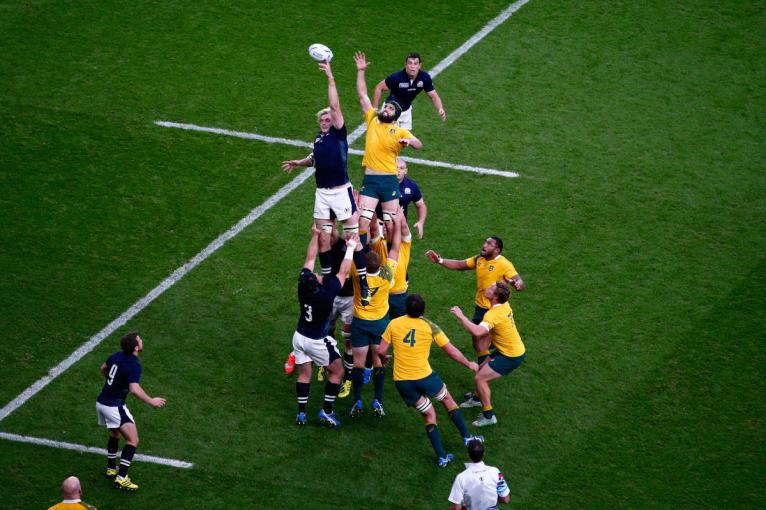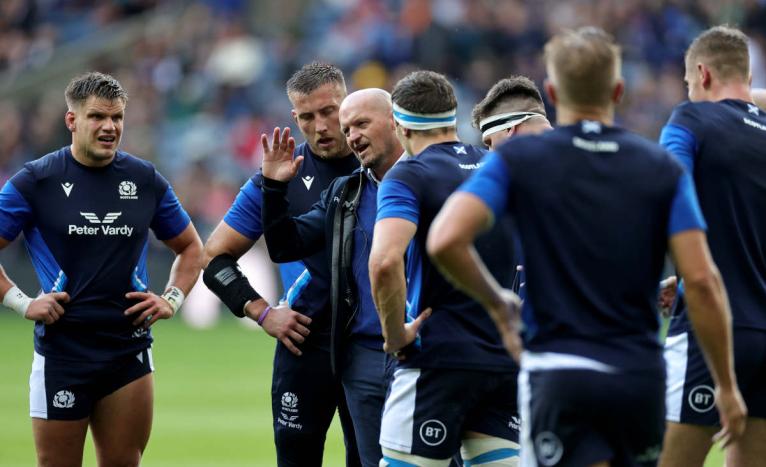Scotland head into their 10th Rugby World Cup with their oldest second row pairing of any tournament, and yet that fact alone has the coaches purring about a new strength in the team.
The squad overall is no older than any that has gone before, with Frank Hadden’s relatively callow 2007 squad that reached the quarter-finals the last time the tournament was hosted by France, the only one below the average age of 27 or 28. This time it’s 27.
Hawick’s Geordie lock Alan Tomes was the oldest Scotland second row to appear in a World Cup, at 35, and Nathan Hines turned 35 two weeks after retiring at the 2011 tournament, but 34-year-old Gray follows a select group of locks to feature in three World Cups, namely Scott Murray, Hines and the late Doddie Weir. He could have been joining Chris Paterson as a four-time World Cup player, but chose not to make himself available for Japan in 2019.
He has a year on his likely second row partner to face South Africa in two weeks’ time, Grant Gilchrist. The pair first played together in Scotland’s under-20s side, with coaches telling anyone who listened that they would be a fixture in Scotland teams for the next decade. Of course, Al Kellock, Nathan Hines and Jim Hamilton were not about to slide over and let the youngsters in, and we had little knowledge then of the impression another Gray, Jonny, five years’ Richie’s junior, would make. But it is fascinating that the two are now reunited as Scotland’s lineout linch-pins, some 15 years later.
International careers rarely follow a straight line and both had periods, some years back, where they believed their Scotland days to be over, and pondered life beyond rugby. Now, they are back fitter and leaner than a decade ago, and fitting into Gregor Townsend’s mould of athletic, mobile forwards who like to get their hands on the ball., keeping out the ‘youngsters’, Sam Skinner (28) and 26-year-old Scott Cummings.

We will come to the dips in that rollercoaster ride shortly, but the excitement levels in Gray and Gilchrist currently are quite bewitching.
“One of the things you learn as you get to our age is that opportunities to play in a World Cup are special,” said Gray, “and so, yes, there is a lot of excitement at being part of this again.
“My first memory of a World Cup was flying into Invercargill, at the bottom of the South Island of New Zealand, and receiving this amazing Maori welcome with hundreds of people packing this little airport, many in kilts, which told you that this was no ordinary tournament. The excitement was incredible all the way through that World Cup in New Zealand.
“But, now, looking to France, and having been fortunate to play for two great French clubs, the excitement is there again because you know the atmosphere will be incredible from start to finish; different to New Zealand, but very, very special because the French love their rugby.
The clearest memory I have, was facing the kick-off against Japan, and thinking ‘this is my first World Cup, just kick to the other side’. Of course, it comes straight to me, but thankfully I caught it.
Grant Gilchrist
“We had a game against France in Saint Etienne two weeks ago and we couldn’t hear each other in the warm-up, and I told the younger boys ‘this is just the start’. It doesn’t matter your age, you feel a special kind of excitement representing Scotland in a World Cup.”
Gilchrist’s first World Cup experience came four years later when Scotland opened their 2015 campaign in Gloucester against Japan, who, with Eddie Jones at the helm, had shocked South Africa in their opening match.
“The clearest memory I have,” recalls Gilchrist, “was facing the kick-off against Japan, and thinking ‘this is my first World Cup, just kick to the other side’. Of course, it comes straight to me, but thankfully I caught it and we were off, and it settled me right in.

“I’ve never taken anything for granted in international rugby, but we’re under no illusions that every single game in a World Cup is hard, and you have to earn everything you get. As lineout specialists, Rich and I know we have to be delivering in these games; the team needs us to deliver. And I think that’s the kind of pressure you relish when you’ve had our experiences. We know that if the front five don’t show up in that first game against South Africa we’re not going to win the game, and you’re on the back foot straight away, and that’s an exciting challenge, and it puts a smile on my face.”
Excitement is one thing, but ability to win Test matches in the white-hot intensity of a World Cup is another. However, the journey the Scots duo have taken points to a new steel in their armoury. Gray’s 6ft 10in height is an obvious benefit, but what really made him stand out as a youngster was his basketball-style approach to rugby – agile, quick and with great hands – underlined with his first Test try 13 years ago where he shrugged off two tacklers before selling Ireland full-back Rob Kearney with an outrageous dummy. His style was as fundamental to Glasgow Warriors’ early success on and off the field as was Finn Russell’s years later, the flowing bleached blond locks adding to a burgeoning superstar status.
I can’t say I enjoyed every minute, particularly the injuries, but I am fitter, I weigh less than I did in France and am more mobile again, and playing as well as I ever have.
Richie Gray
He had a year at Sale Sharks before crossing the Channel and enjoying three seasons at Castres, and four at Toulouse, returning to Glasgow in 2020. Those moves were chosen by Gray and his agent, former Scotland full-back Rowen Shepherd, to help him become a more complete second row, and while he believed they did, they also brought new levels of physical demands and fatigue that led to a string of injuries and a star waning.
“Now, though, when you look back you realise that it all played a part in making you who you are now,” Gray insists. “I can’t say I enjoyed every minute, particularly the injuries, but I am fitter, I weigh less than I did in France and am more mobile again, and playing as well as I ever have. Ultimately, that’s because of that rugby education.

“In 2019, I did think that was it for me. The timing [of the World Cup] wasn’t quite right. We had just had our first child and the idea of being away from the family for several months was tough, but it was also off the back of a lot of injuries. I hadn’t had a run of games for a couple of years, and I just wondered what kind of shape I’d be in to represent my country at a World Cup. Giving how tough this prep has been, where I’ve been fit and able to handle it …
“So, yes, four years ago I thought ‘this might be it; I’ve shut the door on international rugby’. But I try to use that experience to enjoy it now, and remind the younger guys not to take this for granted.”
Would a young Richie Gray have listened to that advice?
“Maybe not,” he laughs. “But that’s the benefit of experience. I can look back and see where I didn’t learn, but also where I did.
“At Glasgow it was great throwing the ball around and having fun, but then suddenly I was in France playing against 140-kilo second rows and if you don’t learn to cope with the nitty-gritty of rugby, the scrummaging, mauling, the hard yards and tough away days, you don’t survive.
Gilchrist is a different player, in style and mentality, a Kiwi-type game-intelligent second row who does the right things consistently without fanfare. Some coaches instinctively prefer Gray, some Gilchrist, but the best packs have a blend of talents
“You learn where your strengths lie, and where you can make a difference. I went there wanting to do everything to help the team, trying to be everywhere, but there comes a point when you realise ‘I’m there for a reason’, and that knowledge is the difference in me now to ten years ago. My first job is the set-piece – if you don’t win your lineout your team can’t do much off it. I’m responsible for that, that’s my job, and anything else I do is a bonus. Of course, I want to get powerful carries, big tackles, off-loads and be involved in the attack, but that’s not my prime job. I learned that in France. Second rows would come off happy if they’d won their own lineouts, stolen a few, and hit a few rucks; that’s it.
“Don’t get me wrong, with Scotland we are playing a quick, enjoyable game, and Gregor [Townsend] likes all of us to get on the ball, because he loves his attacking rugby, but that’s where the experience is key – none of that’s possible if Grant and I, and those around us because everyone plays their part, don’t get our jobs bang on. And we know now that we can create a platform to attack and beat the best teams.”
Gilchrist is a different player, in style and mentality, a Kiwi-type game-intelligent second row who does the right things consistently without fanfare. Some coaches instinctively prefer Gray, some Gilchrist, but the best packs have a blend of talents. Gilchrist agrees that he has learned how to use Gray to best effect in the lineout, and play off him, but he has also learned from his partner’s self-belief.

“In 2019, I went to Japan in full belief that we were going to do well in that World Cup,” he said, “but we came back with just horrible disappointment. But, personally and collectively we went through a reset and started building again towards this tournament, and year on year we’ve got better as a squad.
“It’s not been plain sailing, there have been bumps, but there has been a lot of learning and growing belief that we can win big games,” says the player who has an enviable Scottish record of 36 wins in 64 Tests, including 10 against England, France and Australia.
The biggest difference between 2019 and now for me is that belief right through the squad – we all now know why our game is good enough to beat everyone
“That comes from wins but also big games we let slip. You think of the South Africa game in 2021, where we were winning and had all the momentum in the game as we neared the hour-mark, but we didn’t keep it on them, made silly mistakes and let them creep back in, and lost it.
“The evidence showed that we just had to believe in ourselves a bit more when we were ahead, and also showed how if you slip up slightly you won’t win. That’s where we are now as a team: we’re crystal clear about who we are, what our best game looks like, and it’s about being in the biggest pressure moments and delivering
“Rich and I know we can, but the biggest difference between 2019 and now for me is that belief right through the squad – we all now know why our game is good enough to beat everyone, and our jobs in that. And we understand how tough it’s going to be.”


They must just sort out their defensive patterns and their easy to read attacking lines.